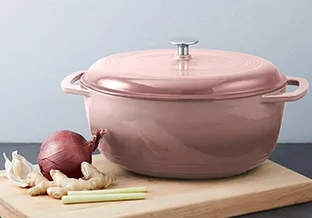
cleaning a rusty cast iron skillet
Cleaning a rusty cast iron skillet can seem like a daunting task, especially for those who are new to using cast iron cookware. However, with the right techniques and methods, restoring your skillet to its former glory is not only possible but also rewarding. Cast iron skillets are beloved for their durability, even heat distribution, and ability to retain seasoning, making them invaluable in any kitchen. Here’s a comprehensive guide on how to effectively clean a rusty cast iron skillet.
Assess the Rust
Before diving into the cleaning process, it is important to assess the level of rust on your skillet. Light rust spots can often be removed with minimal effort, while extensive rust might require a little more elbow grease. Examine the skillet carefully; if the rust is superficial, you might be able to clean it up quickly. However, if the surface has deep pitting, you will need to be more meticulous in your approach.
Gather Your Supplies
You will need a few essential tools and materials to clean your cast iron skillet. Gather the following
1. Steel wool or a stiff brush This will help scrub away the rust. 2. Mild dish soap In small quantities, it can assist in the cleaning process. 3. Vegetable oil or seasoning oil For re-seasoning your skillet after cleaning. 4. Paper towels or a clean cloth For drying the skillet. 5. Baking soda (optional) This can be used to create a paste for tougher rust spots.
Cleaning the Skillet
1. Initial Scrubbing Begin by using the steel wool or stiff brush to scrub the rusty areas of the skillet. Apply some pressure, but be mindful not to damage the cast iron. The goal here is to remove the rust and any food residue without compromising the integrity of the skillet.
2. Using Soap (Optional) Although many cast iron enthusiasts advise against using soap, a small amount can be effective in removing deeper rust stains. If you decide to use soap, apply it lightly with your scrubber and then rinse thoroughly to ensure no soap residue remains.
3. Baking Soda Method For stubborn rust, mix baking soda with a little water to create a paste. Apply this paste to the rusty areas and let it sit for 10-15 minutes. Then scrub with your brush or steel wool. The baking soda will help to lift the rust and make it easier to clean.
cleaning a rusty cast iron skillet

4. Rinsing After scrubbing, rinse your skillet under warm water. Ensure all rust particles and soap are thoroughly washed away.
5. Drying It is crucial to dry cast iron immediately after washing. Use paper towels or a clean cloth to wipe it down completely. To prevent rust from reforming, place the skillet on a low heat burner for a few minutes. This will ensure that all moisture is evaporated.
Re-Seasoning the Skillet
After your skillet is clean and dry, it’s time to re-season it. Seasoning is essential for creating a non-stick surface and protecting the cast iron from rust. Here's how to do it
1. Apply Oil Use a paper towel to apply a thin layer of vegetable oil or seasoning oil on the entire skillet, including the handle.
2. Bake Preheat your oven to 375°F (190°C). Place the skillet upside down on the oven’s middle rack, with a baking sheet below it to catch any drips. Bake for about an hour.
3. Cool After an hour, turn off the oven and allow the skillet to cool inside. This process will create a non-stick layer and help prevent future rust.
Conclusion
Cleaning a rusty cast iron skillet requires minimal effort but can yield significant results. With some patience and the right tools, it’s possible to restore it, ensuring it continues to serve you well for many years. Proper maintenance, including regular seasoning and careful storage, will keep your skillet in excellent condition, allowing you to enjoy its many culinary benefits without the worry of rust. Embrace your cast iron skillet's potential, and it will surely reward you with countless delicious meals!
-
Season Cast Iron Perfectly with GPT-4 Turbo TipsNewsAug.01,2025
-
High Quality Cast Iron Cookware - Baixiang County Zhongda MachineryNewsAug.01,2025
-
Premium Cast Iron Pan: Durable & Perfect HeatNewsAug.01,2025
-
High Quality Kitchen Durable Black Round Cast Iron Cookware Pancake Crepe Pan-Baixiang County Zhongda Machinery Manufacturing Co., Ltd.NewsAug.01,2025
-
Cast Iron Cookware - Baixiang County Zhongda Machinery | Nonstick, Heat ResistanceNewsAug.01,2025
-
High Quality Kitchen Durable Black Round Cast Iron Cookware - Baixiang County Zhongda Machinery | Non-Stick, Heat Retention, DurableNewsJul.31,2025


